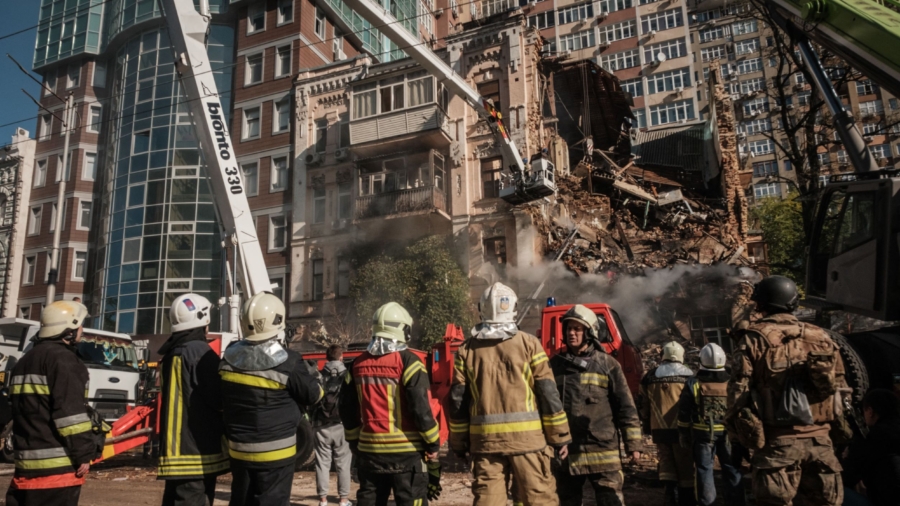The Russian military struck positions throughout Ukraine—including the capital Kyiv—on Oct. 17, as Western powers promised to ramp up support for the beleaguered nation.
According to Ukrainian officials, Russian forces used drones to hit targets in Kyiv, while also shelling multiple positions elsewhere in the country.
“Kamikaze drones and missiles are attacking all of Ukraine,” Ukrainian President Volodymyr Zelensky said via messaging app Telegram, claiming that at least one residential building in Kyiv had been struck.
“The enemy can attack our cities, but it won’t be able to break us … we will get victory,” Zelensky said.
Ukrainian officials said the Kyiv attacks—which reportedly killed at least three people—had featured Iranian-built “suicide drones,” which detonate themselves upon reaching their targets.
Iran, for its part, has repeatedly denied that it is supplying combat drones to Russia, while the Kremlin has refrained from commenting on the claims.
Last month, Ukraine revoked the credentials of Iran’s ambassador to Kyiv amid allegations that Tehran was supplying Russia with advanced Shahed-type unmanned aerial vehicles.
The latest strikes come one week after Russian forces carried out a similar barrage of drone and missile attacks targeting what Moscow described as “critical infrastructure” in Kyiv and other parts of Ukraine.
That initial wave of attacks on Oct. 10 came shortly after a road-and-rail bridge linking mainland Russia to the Crimean Peninsula was severely damaged by a deadly truck bombing for which Moscow has blamed Ukraine’s clandestine services.
Allies Vow More Support
Kyiv’s Western allies, meanwhile, have reiterated their ongoing support for Ukraine in the face of steadily escalating bombardments by Russian forces.
On Oct. 16, France pledged to provide Ukraine with advanced air-defense systems and expand training programs for Ukrainian military personnel. Two days earlier, the United States announced plans to provide Ukraine with a fresh $725 million military-aid package.
What’s more, on Oct. 17—as Russia was striking targets in Kyiv—NATO began conducting nuclear exercises over the skies of northwestern Europe.
Fourteen of the alliance’s 30 member states are set to take part in the annual wargames, which will be held over the North Sea and in UK and Belgian airspace until the end of October.
And in a notable shift on Oct. 16, Nachman Shai, Israel’s Minister of Diaspora Affairs, urged his country to increase military assistance to Ukraine.
Until now, Israeli contributions to the Ukrainian war effort have been largely confined to non-lethal military equipment.
Echoing recent claims in the U.S. media that Iran was supplying ballistic missiles—as well as drones—to Russia, Shai said in a post on Twitter: “There is no longer any doubt where Israel should stand in this bloody conflict.”
“The time has come for Ukraine to receive military aid [from Israel] as well,” he asserted, “just as the USA and NATO countries provide.”
Dmitry Medvedev, deputy chairman of the Russian Security Council, responded to Shai’s appeal by saying, “Israel seems to be planning to send weapons to the Kiev regime. This is a very reckless move.”
Speaking on Telegram, Medvedev added: “It will destroy all interstate relations between our nations.”
Steadily Escalating Conflict
The military situation in Ukraine has steadily escalated since Sept. 30, when Moscow formally incorporated four regions of the country—Donetsk, Luhansk, Zaporizhzhia and Kherson—into the Russian Federation.
The move followed referendums held in all four regions, in which a majority of residents voted to join Russia, according to Russian and pro-Russian sources.
Kyiv and its Western allies, however, say the step amounts to the unilateral “annexation” of the territories by Russia, and refuse to recognize the results of the polls.
Russian forces and their local allies currently hold about 60 percent of Donetsk and almost all of Luhansk.
Together, the two territories comprise the Russian-speaking Donbas region, which has remained the primary focus of Moscow’s “special military operation” in Ukraine, which began almost eight months ago.
Pro-Russian figures in Donbas say that, since 2014, the region’s civilian populations have suffered frequent abuses—largely ignored by the Western media—at the hands of the Ukrainian army and paramilitary groups.
Authorities in Kyiv, for their part, deny the claims.
Russian forces also currently control roughly 70 percent of the southern Zaporizhzhia region and almost all of neighboring Kherson.
All four regions remain the scene of frequent fighting, mostly in the form of tit-for-tat artillery barrages across the roughly 1,100-kilometer-long frontline.
Both sides continue to accuse each other of shelling civilian areas. On Oct. 16, pro-Russian officials in the city of Donetsk accused the Ukrainian military of targeting the local mayor’s office.
The Epoch Times was unable to verify the claim.
Reuters and the Associated Press contributed to this report.
From The Epoch Times


